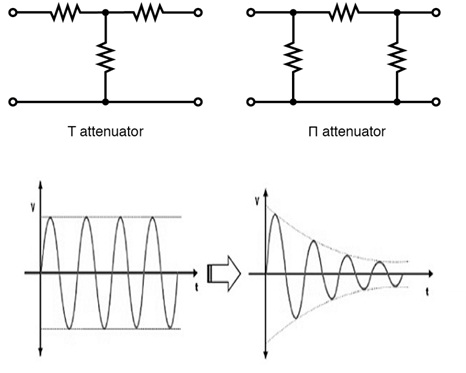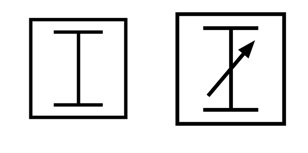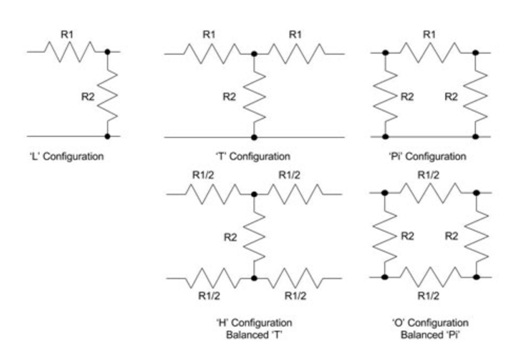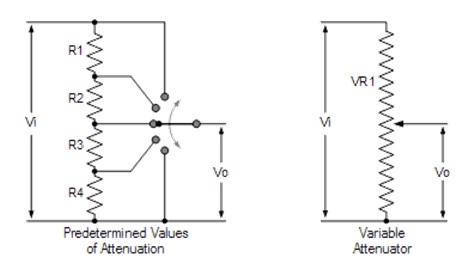Electricity, communication, entertainment, utility resources (gas), etc. everything is required to be transmitted from one point to another. For transmitting these, there are different type of technologies and transmitting techniques. Electrical power generated at one place is transmitted to consumer point using transmission lines along with required substations. For transmitting power from one point to another point, amplifiers are used to increase the power of signal and are called as amplification. Similarly, while transmitting signals over long distances the power of signal may gradually reduces this is termed as attenuation. In this article, we will discuss in detail about what is an attenuator, design of attenuator, different type of attenuators, and attenuator applications.
What is Attenuator?
Definition: Every signal that includes electrical, telecommunication, entertainment signal (television), etc.should be transmitted from one place to another place through a medium.As the distance of signal travelled increases the strength of signal decreases and it will be difficult for a lot of tasks. But, attenuation, phenomenon of gradual loss of strength of signal over distance is still useful in many tasks. Attenuators are simple passive two-port electronic devices that are used for attenuation, to reduce strength of signals without causing disturbance to its waveform.

attenuator-circuits-and-attenuation
Design of Attenuators
Attenuator is a simple passive two-port electronic circuit as it is completely built using passive components, resistors. Attenuator is designed by positioning resistors to form a voltage divider network. Attenuator design can be changed based on various factors that include balanced, unbalanced and unidirectional, bidirectional.

fixed-and-variable-attenuators
Simple designs of attenuator will be as shown in the below figures:
- Attenuators can be designed using passive resistors, PIN diodes, and FET.
- Attenuators can be designed using passive resistors, which are used for providing fixed levels of attenuation.We can add as many numbers of attenuation sections as required for providing required levels of fixed attenuation.
- Attenuators can be designed using PIN diodes and these attenuators are used for providing variable levels of attenuation.
- Attenuators can be designed using FET RF attenuators and these attenuators are used for providing continuously variable levels of attenuation. Both PIN diode and FET attenuators use an analogue control voltage for controlling the attenuation levels.
Types of Attenuators
Attenuators are designed using different types of circuit layouts such as pi, T, L, H and O configurations.There are different types of attenuators classified based on their circuits i.e., symmetrical which are balanced circuit configurations and asymmetrical which are unbalanced circuit configurations. The different shaped attenuator circuits are shown in the below figures.

types-of-attenuators
Attenuators are majorly classified into three types fixed attenuators, variable attenuators and step attenuators.
Fixed Attenuator
As the name indicates, fixed attenuators are type of attenuators that are used for fixed attenuation levels. These types of attenuatorsare mostly available in a surface mount or connectorized package. You can avail different fixed attenuation levels with this these products in a series.
Variable Attenuators
These types of attenuators are exactly opposite to the fixed attenuators as these are used for variable attenuation levels. Variable attenuators can be used to provide a different attenuation level as there as an option to regulate and get required attenuation level. This can be achieved by varying the input voltage applied to the control line.

variable-attenuator
Step Attenuators
Step attenuators are used to provide fixed steps of attenuation levels. These are almost similar to fixed attenuators but with an extra advantage of facility to provide different fixed attenuation levels in pre-calibrated steps. This can be achieved using chip, coaxial and waveguide formats.
There are many other attenuators that include radio frequency attenuators which typically have coaxial structure with accuracy, low SWR, repeatability as major characteristics; and audio attenuators which is a line-level attenuator used for reducing output volume of speaker.
Attenuation in Networking
In the communication systems both the digital and analog signals will be transmitted from one point to another. If signals are transmitted over long distances then there will be some reduction in the strength of signals which is termed as attenuation. Similarly, in the computer networking when data signals or communication signals are transmitted over a long distance then there will be phenomena of attenuation. This is because of range and interference.
Attenuator Applications
There are so manyattenuator applications that we can observe in our daily life and a few of them are listed below:
- Microwave power can be controlled using PIN diode attenuators, PIN diode is used as control element in most of the electronically variable attenuators.
- To control volume of electronic equipment such as speakers, electric guitars, etc. attenuators are used.
- In general, while conducting tests in laboratories only a small voltage or current signal is used for which attenuators are widely used to reduce output signal strength.
- To test high power radio frequency signals, before applying it to the test equipment you should reduce the strength of the signal for which attenuators can be used.
- While driving match sensitive radio frequency mixers it is really important to ensure that proper impedance match is obtained as poor match can lead to degraded performance. So, impedance matched radio frequency attenuator can be used to improve this matching and improve performance.
- In some digital or analog circuits, a surge in voltage may cause damage to the circuits which can be avoided using attenuators to reduce high voltages.
- In fibre optic communication, it is important to obtain proper match for transmitter and receiver which can be obtained using optical attenuators.
- Basic signal generators will be able to generate an exact fixed level and to use this output signal we must use switch attenuators to reduce its signal which is less effective method compared to using a variable level control radio frequency attenuator that can be used to generate required levels.
Thus, this is all about an overview of attenuator like its defitinition, design, attenuation in networking, different types and their applications. You can find out more information about attenuators and its applications by posting your queries in the comments section below. Here is a question for you, what is the function of an attenuator?